Facilities
Education and Research Building (Banjokan)
 Education and Research Building (Banjokan)
Education and Research Building (Banjokan)
Situated in the center of the extensive sports facilities at the Kyotanabe Campus, the education and research building of the Faculty of Health and Sports Science, Banjokan, houses a range of facilities, including seminar rooms where seminars and first-year programs are conducted, laboratories where students acquire cutting-edge knowledge and skills in sports science, a library which houses a collection of sports journals and specialized books on health and sports science, a multi-purpose practice room where students can engage in physical activities such as fitness and dancing, a conference room for presentations, and a learning area where students can engage in private study.
Exercise and Sports Physiology Laboratory I
In this laboratory, the amount of respiratory gas exchange and metabolic reaction during exercise on treadmill or bicycle ergometer can be measured. In addition, aerobic/anaerobic capacity can be evaluated based on the measured results, and training effectiveness can also be determined. A large treadmill allows for specific measurements tailored to each sports subject (running, walking, Nordic walking, roller skiing roller blading, and bicycle etc.). The laboratory is also equipped with a hypoxic training room (with a simulated altitude of up to 4,000 meters) that can accommodate 6 to 8 people, where high altitude training experiments can be conducted based on the results of the orthostatic tolerance test, blood test, urine test and oxygen saturation level during exercise.
Exercise and Sports Physiology Laboratory II
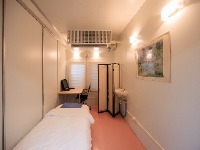 Exercise and Sports Physiology
Exercise and Sports Physiology Laboratory II
This laboratory is equipped with metabolism measurement devices for the study of physiology and nutriology, including a Human Calorimeter and an Environment Control Room. The Human Calorimeter, which is comprised with the world’s most advanced, analytical instruments, enables one to measure his/her metabolic rate (calorie consumption), simply by being present in the measurement room. In the Environment Control Room, not only can the room temperature and humidity be controlled, but can also create a hypoxic environment. This enables practical studies such as hypoxic training experiments to be conducted. A simplified device for measuring calories in food is also available for use in the laboratory, creating a facility that enables comprehensive evaluation of intake and consumed calories.
Environmental Physiology Laboratory
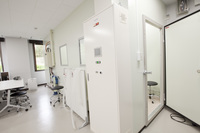 Environmental Physiology Laboratory
Environmental Physiology Laboratory
Dr. Fukuoka is a respiratory physiologist interested in the integrative control of breathing in humans during hypoxia and exercise. The first research interest is focused on the impact that exposure to sustained or episodic hypoxia has on the interaction between central and peripheral chemoreflex, and respiratory plasticity (i.e. long-term facilitation and progressive augmentation) that have in the control breathing during rest and exercise. He has used human model to investigate this interest. The long-term goal of his research is to determine the potential impact that episodic hypoxia may have on breathing stability in individuals with sleep apnea, spinal cord injury, and endurance athletes. The second research interests in Dr. Fukuoka’s laboratory focus on muscle and cardiovascular responses to exercise, including muscle oxygenation, and on the metabolic and circulatory changes during heavy exercise in humans. He have developed a devise on noninvasive techniques, including breath-by-breath gas exchange, near infrared spectroscopy and vascular ultrasound, with which to examine the coupling of oxygen delivery to oxygen utilization by skeletal muscle during exercise in humans.
Motor Control Laboratory
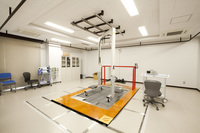 Motor Control Laboratory
Motor Control Laboratory
This laboratory has devices for obtaining neurophysiological data directed toward clarifying motor control and learning mechanisms in humans. A wireless electromyogram system enables the measurement of the electrical activities produced by muscles. An electrical stimulator is capable of measuring excitability of spinal reflex induced by transcutaneous nerve stimulation. Researches on brain function using a transcranial magnetic stimulation (TMS) are also in progress. In addition, the laboratory has a large-size treadmill, digital video cameras, electrogoniometers, and accelerometers for studying dynamic human movements.
Training Science Laboratory 1
Understanding basic human body functions is essential for the improvement of sports performance, as well as the maintenance and enhancement of health. This laboratory is equipped with devices for measuring abilities related to physical strength. General measuring instruments, such as a weight scale and stadiometer, are available for anthropometry. For measuring the components of physical strength, there is a hand grip dynamometer (for determining muscle strength) and a long seat-type body anteflexion device (for measuring flexibility), as well as devices for measuring vertical jumps, standing broad jumps, sideways jumps, etc. Knowledge obtained from the measurement results is put to use in daily training and instruction.
Training Science Laboratory 2
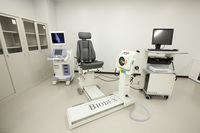 Training Science Laboratory 2
Training Science Laboratory 2
In this laboratory, human body composition (size of skeletal muscle and fat, and percent body fat, etc.), muscle strength and power, and neuromuscular functions can be measured. These data are used to evaluate physical fitness and examine the changes by training. An ultrasonic apparatus in the laboratory can visualize the behavior of muscle fiber and tendon during human movements in real time with high speeds. There is an isokinetic dynamometer for measuring maximal muscular strength, power and endurance. The dynamometer is used to assess neuromuscular functions with simultaneous recordings of electromyograms.
Laboratory of movement theory and practice on phenomenological and pedagogical grounds
phenomenological and pedagogical grounds
This laboratory will be as a gathering place for students and faculty members to acquire
and grow in knowledge through discussion and experimentation.
The following shows the main research areas;
- Experiments and studies on sports and exercise, generation of ‘waza’ (skills or techniques), mastership, alteration and instruction.
- Filming and analysis of various sports and exercises by high-speed video cameras
- Game analysis
- Split time and lap time measurement
- Measurement of cerebral function with a GO/NO-GO task (enables indirect investigation of frontal lobe of the cerebrum)
- Physical and athletic ability measurement
- Measure speed by speed gun
- Research on ball game (Ballschule in German) and active school (Bewegte Schule in German)
Physical Fitness Science Laboratory
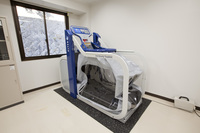 Physical Fitness Science Laboratory
Physical Fitness Science Laboratory
This laboratory is equipped with measurement tools related to body composition and physical strength. For work on body morphology and components, available devices include everything from general instruments, such as a stadiometer, to a device for measuring body fat and muscle mass by the Impedance Method and a state-of-the-art ultrasound bone densitometer. For the examination of physical strength, there is a device for measuring muscle strength and flexibility, as well as a device for measuring isokinetic strength. Through the use of these tools, the ‘athletic qualities’ deemed necessary for athletes in various sports can be studied, allowing for the development of relevant training methods geared toward achieving optimum athletic performance. Of course, the laboratory’s equipment can be used to monitor and maintain the physical condition of athletes and non-athletes.
Sports Biomechanics Laboratory
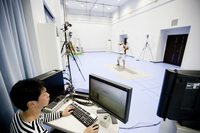 Sports Biomechanics Laboratory
Sports Biomechanics Laboratory
The sports biomechanics laboratory is investigating the performance of the sports and daily activities, through the accurate measurement of human body motions. The sports motions, such as the throwing motions for baseball, the kicking motions for soccer and etc., are measured using the state-of-the-art motion capture system in our large laboratory. The motion capture system is equipped with the six CCD cameras and four force plate. The joint angles, joint moments and activities of muscles are estimated by the measured motion data, using the musculoskeletal modeling software, in order to investigate the load relative to the joint.
Sports Psychology Laboratory
This laboratory is equipped with many apparatuses for psychology-based research focusing on the process where humans respond behaviorally to external information processed through the senses of vision, auditory and so on. For example, the differences of visual search pattern of beginner and advanced athletes in various sports can be analyzed. Reaction times, EEG, as well as vision and movement (visuomotor skills) under psychological pressure, can also be evaluated. In addition, to develop efficient practice methods for various sport skills, it can be examined how different practice methods influence specific body movements and how these affect the way in which an athlete searches for visual cues, arousal level, and psychological self-evaluations.
Sports Medicine Laboratory
In this laboratory, body morphology and function can be evaluated using medical diagnostic equipment. Specific measurements and evaluations include 12-lead electrocardiogram and blood pressure measurement, as well as the ankle-brachial index (ABI) test and the pulse wave velocity (PWV) test for evaluating the risk of arterial stiffness. In addition, various data on the body can be measured, for example, evaluation of peripheral nerve function through the nerve conduction velocity test, measurement of body surface temperature by thermography, examination of the inside of the body using a portable ultrasound diagnostic device (two machines are available), and bone mass measurement using a ultrasound bone mineral density measurement device. Training for sports injury taping, as well as for cardiopulmonary resuscitation using AED, is also provided in the laboratory.
Biochemistry Laboratory / Molecular Biology Laboratory
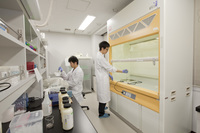 Biochemistry Laboratory /
Biochemistry Laboratory / Molecular Biology Laboratory
These laboratories are equipped with the experimental devices for biochemical and molecular biology analysis, such as chemiluminescence detector, real-time PCR, spectrophotometer and electropolator etc, which enable us to measure enzyme activity, protein expression level, gene expression level and transcriptional activity due to luciferase reporter assay in skeletal muscle, adipose tissue. By using these experimental techniques, we can examine the response to acute exercise and the adaptation to chronic exercise and immobilization, and the molecular mechanism for above response and adaptation in those organs.
Exercise Prescription Laboratory
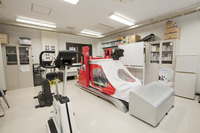 Exercise Prescription Laboratory
Exercise Prescription Laboratory
This laboratory is equipped with devices for measuring energy consumption, muscle strength and power, making it possible to investigate what kind of physical activities and exercises should be developed and implemented for the improvement of athletic performance, physical fitness and health. The laboratory also has the most advanced anti-gravity treadmill currently available, which is designed to reduce weight-bearing by air pressure, making it ideal for the study of rehabilitation and new training methods. In addition, there are a number of physical activity measurement devices (pedometer type), enabling the analysis of physical activity amount and intensity in everyday life settings, away from the laboratory.
Conditioning Room
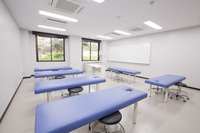 Conditioning Room
Conditioning Room
This room is designed to conduct experiments for acquiring a range of techniques to improve physical fitness, including taping for injury care and protection, and fatigue-relieving massage. Practical training for emergency first aid, such as applying an automated external defibrillator (AED) and the cardio-pulmonary resuscitation (CPR) method, and general surgical procedures during sports activities can also be carried out.
Sports Marketing Research Practice Room
 Sports Marketing Research Practice Room
Sports Marketing Research Practice Room
This practice room adopts a system for analyzing consumer behavior related to participants of sports events and spectators of professional sports. Its platform allows for the collection of data through a large-scale online survey. The SPSS predictive analytics software is used for analyzing collected data. By applying conjoint analysis that measures consumer preferences, the buying behavior of sports consumers can be predicted. Also, behavioral patterns of sports consumers can be mapped with the Geographic Information System (GIS).
Sports Facilities
To support students’ sports activities at all levels, Doshisha University offers extensive, high-quality sports
facilities.
At the Faculty of Health and Sports Science, you can aim at improving athletic performance, or work to enhance
coaching skills. We offer you the chance to take the lead in a new age of health and sports on a course that will
test and challenge your physical and mental ability to the fullest.
For detailed information about the sports facilities, please visit ‘Sports facilities’ on the official website of
Doshisha University:
http://www.doshisha.ac.jp/en/information
/facility/sports/kyotanabe.html
| For inquiry, please contact : |
Office of Faculty of Health and Sports Science and Graduate School of Health and Sports Science
TEL : 0774-65-6030 |
|---|